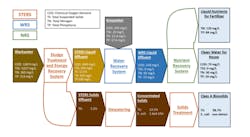4 Companies Improving Technologies with EPA Funding
About the author:
Arianna Berry is a freelance writer for Water & Wastes Digest. Berry can be reached at [email protected] or 904.451.1565.
In 2020, EPA’s Small Business Innovation Research (SBIR) program launched an open solicitation inviting project pitches from small businesses developing environmentally beneficial technologies. Public health topics included per- and polyfluoroalkyl substances (PFAS) destruction, ethylene oxide monitoring, water reuse, and sustainable construction materials.
In March of 2021, 25 Phase I recipients were announced and awarded $100,000 each to develop and commercialize their concepts through August 31, 2021. In January 2022, the EPA awarded nine of them up to $400,000 of additional Phase II funding to build upon Phase I progress. Here we look at four of those nine companies, how their technologies work, and the ultimate goals for the products.
1. Aquagga, Inc.
Advancement Being Funded
Hydrothermal alkaline treatment (HALT) process for destroying PFAS in contaminated groundwater.
Alaskan-based water treatment technology company Aquagga (‘Aqua’ + ‘Quagga’) is working to address a hot industry topic: the “PFAS destruction problem.” It uses a bolt-on platform and alkaline hydrothermal treatment to remove PFAS from water supplies, converting toxic wet waste into clean water.
How It Works
PFAS are persistent and highly recalcitrant environmental pollutants and bioaccumulative toxins. Aquagga is working on effective and affordable systems that remove and destroy water supply PFAS at the end of their useful life.
Deployment Goals
In Phase I, Aquagga demonstrated that a continuous HALT reactor could destroy >99.9% of total PFAS in a contaminated liquid sample from a fire training pit. The result was consistent and repeatable.
Aquagga’s continuous HALT reactor destruction tests showed faster destruction rates than similar batch reactor systems. Aquagga also designed a pilot-scale HALT system and identified viable sites to test it. In this Phase II project, Aquagga is partnering with the University of Washington to develop a pilot-scale HALT reactor to dispose of PFAS-contaminated wet wastes.
The HALT system will be ready to transition towards contracted commercial deployments at active PFAS remediation sites by the end of the Phase II project in 2022 and 2023.
2. Hyperion Analytical LLC
Advancement Being Funded
A fully automated analytical system for N-nitrosamines to support water reuse applications.
Hyperion Analytical LLC was established to develop and commercialize innovative scientific and analytical instrument technologies. Principals Duncan Griffiths and William Bernt have about six decades of combined experience in particle characterization.
Trace organic compounds are a major challenge for water reuse. N-nitrosamines and probable carcinogen N-Nitrosodimethylamine (NDMA) are two compounds that present in treated wastewater.
Many drinking water treatment plants and other industries that monitor for N-nitrosamines stand to benefit from this fast, reliable, and automated technology as well.
In addition to facilitating safe water treatment to benefit the environment, this technology uses significantly less toxic solvent for sample extraction and minimal other reagents.
How it Works
The two functional, laboratory-based prototypes built during Phase I out-shined commercially available mass spectrometer-based systems at measuring N-nitrosamines in sample matrices. Additional engineering should produce an admirably market-ready commercial product.
Phase II includes extending the lower detection limit further into regulatory range and fully realizing the potential for continuous, unattended, online operation. The product should meet or exceed the performance and speed of laboratory techniques for a fraction of the cost.
Deployment Goals
Advanced water treatment facilities are the ideal customers. Purported benefits include faster analyses, no need for highly skilled staff, smaller sample and reagent volume requirements, and equipment capital costs savings of up to 75%.
3. Pure Blue Tech Inc
Advancement Being Funded
Anti-fouling membranes integrated with polyvinylidene fluoride transducers to promote efficient water reuse.
Pure Blue Tech Inc. has been designing, developing, manufacturing, and implementing membrane systems since 1969. Their self-cleaning membrane elements allow industrial companies and municipalities to address water and wastewater with less money, maintenance, chemicals, downtime, and waste disposal.
They are currently developing water-treatment membranes integrated with thin polyvinylidene fluoride (PVDF) transducers.
How it works
Ultrasonic PVDF transducers embedded into membrane systems preemptively mitigate fouling by disrupting cake layer formation, particle agglomeration, salt and silica precipitation, and concentration polarization.
The reduced membrane fouling afforded by ultrasonic technology makes membrane maintenance and replacement more affordable, increases flux throughput as well as the life of reverse osmosis membranes. This innovation can reduce fouling up to half and reduce the need for expensive pretreatment systems.
A small prototype crossflow membrane system made and evaluated during Phase I concluded that ultrasound generation by PVDF transducers effectively reduced membrane fouling.
EPA awarded Pure Blue Tech Inc. $400,000 for Phase II, as environmental benefits include reductions in cleaning chemical usage and discharge volumes.
Deployment Goals
Pure Blue Tech’s innovation applies to the new build and retrofit water reuse markets and the target municipal customers are wastewater treatment plants with Wastewater Reverse Osmosis (WWRO) plans. If this technology succeeds, municipal facilities could cut overall systems capital costs and space requirements by almost 50%.
Industrial customers are wastewater plant owners, and operators committed to reusing, sustainability, and process improvements are ideal customers.
4. Triangle Environmental Health Initiative, LLC
Technological advancement being funded: Zero-waste system to maximize chemical energy potential in wastewater and produce three valuable reuse output streams.
Triangle Environmental was founded in 2016 “with a mission to provide water, sanitation and hygiene (WaSH) based solutions” internationally to people without access to proper sanitation.
Aging sewer infrastructure and increased sewer demand mean more onsite wastewater treatment systems (OWTS) in the US. These basic systems come with the inconvenience of emptying and transporting the concentrated brine streams they create.
ZeWa reduces the chemical energy potential contained in wastewater to produce zero-waste and three valuable reuse output streams: clean water for non-potable reuse, concentrated fertilizer, and Class A biosolids for local soil amendment.
How it works
The proposed ZeWa system eliminates brine streams and uses the chemical energy potential produced in wastewater to convert it into clean water for non-potable reuse, treated fertilizer for local nutrient supply, and Class A biosolids for local
soil amendment.
Per the project description, “The ZeWa system consists of three subsystems; 1. sludge treatment and energy recovery subsystem (STERS), 2. water recovery subsystem (WRS) and 3. nutrient recovery subsystem (NRS). The team already possesses functional prototypes of the WRS and NRS for testing.”
For Phase I, a lab-scale ZeWa system was made and tested with real blackwater (human urine, feces, and flush water) and greywater (laundry and bathroom sink). The system produced final solid and liquid outputs which met national and international standards for reuse (EPA, NSF, and ISO).
In Phase II, Phase I lessons are being applied to designing, building, and testing the updated solids handling system.
Deployment goals
Findings indicate that the ZeWa system could combine greywater and blackwater streams for easy and efficient household treatment. Once completed, the system will be piloted at a suitable wastewater treatment plant, with more test sites to follow.
More on the EPA SBIR Loan Program
These are just four of nine great emerging technologies the EPA is investing in to address environmental problems. Should they succeed, the savings recognized would far outweigh the investment, so we enthusiastically follow their progress.
- To learn more about EPA’s SBIR program visit: https://www.epa.gov/sbir
- Learn more about the Federal SBIR Program: www.SBIR.gov

